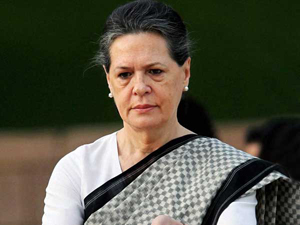Mumbai, Dec 28: In an embarrassment to Congress, articles in its mouthpiece today criticised Jawaharlal Nehru's policy on Kashmir issue and alleged that Sonia Gandhi's father was a "fascist soldier", leaving the party squirming over the controversy on its Foundation Day.
 An unsigned write-up in the Mumbai unit's journal, coinciding with the party's 131st foundation day, blamed Nehru for "the state of affairs in Kashmir, China and Tibet" even as another write-up made controversial remarks on party chief Sonia Gandhi, forcing its editor and Congress leader Sanjay Nirupam to order inquiry even as he claimed he was unaware of the content.
An unsigned write-up in the Mumbai unit's journal, coinciding with the party's 131st foundation day, blamed Nehru for "the state of affairs in Kashmir, China and Tibet" even as another write-up made controversial remarks on party chief Sonia Gandhi, forcing its editor and Congress leader Sanjay Nirupam to order inquiry even as he claimed he was unaware of the content.
Both these articles, which do not bear the name of the writer, have been published in this month's issue of 'Congress Darshan' Hindi edition as a tribute to the country's first Home Minister Sardar Vallabbhai Patel on his death anniversary on December 15.
The article states that Nehru should have listened to Patel's views on international affairs and that the relationship between the two leaders remained strained.
"Despite Patel getting the post of Deputy Prime Minister and Home Minister, the relations between the two leaders remained strained, and both had threatened to resign time and again," the article says.
If Nehru had embraced Patel's foresight, many problems in international affairs would not have arisen, it adds.
The article cites a letter that Patel purportedly wrote in 1950 to caution Nehru against China's policy towards Tibet and in which "Patel described China as unfaithful, and a future enemy of India."
"Had Patel been heard (by Nehru) then, the problems of Kashmir, China, Tibet and Nepal wouldn't have existed now. Patel opposed Nehru's move of taking the Kashmir issue to the UNO," stated the article, adding, "Nehru did not agree with Patel's views on Nepal."
Another article, which focuses on the Congress President, describes her early life in great detail, including her "ambition to become an airhostess", as well as allegation that her father was a member of the Italian forces that lost to the Russians in the World War.
"Sonia Gandhi's father Stephano Maino was a former fascist soldier," it alleged.
The write-up also describes how Sonia quickly rose to the position of party president.
"Sonia Gandhi registered as a primary member of the Congress in 1997 and became the party’s president in 62 days. She also made an unsuccessful attempt to form a government," the article says.
Mumbai Regional Congress Committee chief and editor of the journal Sanjay Nirupam said he is not involved in the day-to-day functioning of the magazine and was unaware of the articles.
"I admit the mistake. Inquiry will be initiated against the editorial department which committed the mistake. We will take measures that such a mistake is not repeated," Nirupam said.
In Delhi, Congress leaders Salman Khurshid and Raj Babbar said that it should be seriously looked into.
"If something like this has come out in the Congress article, then AICC will take it up," Khurshid said.
Congress leader Ghulam Nabi Azad said that it was clear that the writer was not aware of history and had no knowledge of the conditions under which Nehru had become the first Prime Minister and the challenges he faced like eradicating poverty.
Top Congress leaders had gathered to mark the Foundation Day at at AICC headquarters in the national capital.





Comments
Do Republicans like Chris Christie and Rand Paul push
away moderate general election voters when they speak out
versus vaccination?
Look into my blog post: seattle retail
weed: http://1000islandsregion.com/__media__/js/netsoltrademark.php?d=recreat…
As an expert in the wealth management field, this is old
news. My charge to my clients is to get their finances in line with their enthusiasms, virtually all of which do not include \just make more money.\"
To paraphrase King Crimson, wealth is never ever the end in itself but
a way to the end. What is completion? Hey, that's for you
to find out. Bar's like the NYT and others simply play in addition to the
anxiety and fears of their readers and marketers to enhance their own bottom line, and to me that is the supreme cynicism.LikeLike
Here is my website - houston personal injury attorney: http://www.google.com"
Tim, I'm a little dissatisfied by your last point. What if it wasn't about winning, ever?\That man makes $1,000,000 a day as a hedge fund supervisor? I donâEUR ™ t careâEUR\"his golf swing draws and he has love deals with.\"Ok, but if he's having a good time and fits in his body, I 'd say he still wins. I 'd say you've won the video game of life when you stop stressing over winning the game of life.And do not take any mysterious pills!LikeLike
Feel free to visit my web page ... criminal case: http://www.google.com"
Add new comment